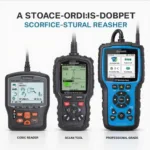Coil codes are a common sight for many car owners when they hook up their OBD2 scanners. These codes, often starting with P03, indicate an issue with the vehicle’s ignition system, specifically the ignition coils. But what do these codes mean, and how can you decipher them to effectively diagnose and fix the problem?
Deciphering Coil Codes: What Your OBD2 Scanner is Telling You
Your car’s ignition system is responsible for generating the spark that ignites the air-fuel mixture in the cylinders, ultimately powering your engine. The ignition coil plays a crucial role in this process by converting the battery’s low voltage into the high voltage needed to create the spark. When your OBD2 scanner displays a coil code, it signals a problem with this voltage transformation or the coil’s ability to deliver the spark effectively.
Common coil codes include:
- P0300: Random/Multiple Cylinder Misfire Detected
- P0301: Cylinder 1 Misfire Detected
- P0302: Cylinder 2 Misfire Detected
- P0303: Cylinder 3 Misfire Detected
- …and so on, with the last digit indicating the affected cylinder.
These codes can be triggered by a range of issues, from a faulty coil pack to damaged spark plugs or wiring. Understanding what each code signifies is the first step in accurate diagnosis and repair.
Common Causes of Coil Codes: Identifying the Root of the Problem
While a coil code directly points to the ignition system, various underlying issues can be the culprit. Here are some of the most common causes:
- Worn-out Spark Plugs: Spark plugs have a limited lifespan and, over time, wear down, affecting their ability to spark effectively.
- Faulty Ignition Coils: Like spark plugs, ignition coils can also wear out or become damaged, leading to weak or inconsistent sparks.
- Damaged Wiring: Wiring issues, such as frayed or corroded wires, can disrupt the electrical signals to the coils, causing malfunctions.
- Vacuum Leaks: Leaks in the engine’s vacuum system can disrupt the air-fuel mixture, leading to misfires and triggering coil codes.
- Fuel System Problems: Issues with fuel delivery, such as a clogged fuel filter or malfunctioning fuel injectors, can also cause misfires.
Troubleshooting Coil Codes: Steps to Effective Diagnosis
- Read the Code: Connect your OBD2 scanner and note down the specific code.
- Research the Code: Use a reliable online resource like OBDFree to understand the code’s meaning and potential causes specific to your vehicle make and model.
- Inspect the Components: Visually inspect the spark plugs, ignition coils, and related wiring for any visible damage, wear, or loose connections.
- Test the Components: Use a multimeter to test the resistance of the ignition coils and spark plug wires to check for continuity and proper function.
- Check for Vacuum Leaks: Inspect the vacuum hoses and intake manifold for any signs of leaks or cracks.
- Address the Underlying Issue: Once you’ve identified the root cause, address it by replacing faulty components, repairing damaged wiring, or fixing vacuum leaks.
Preventing Coil Codes: Maintaining a Healthy Ignition System
2001 obd2 codes.for chevy silverado
Preventing coil codes involves proactive maintenance of your vehicle’s ignition system. Here are some tips:
- Regular Spark Plug Replacement: Follow the manufacturer’s recommended service intervals for spark plug replacement.
- Periodic Ignition Coil Inspection: Regularly inspect your ignition coils for signs of wear or damage.
- Maintain Proper Wiring: Ensure all wiring connections are secure and free from corrosion.
- Address Vacuum Leaks Promptly: Fix any vacuum leaks as soon as they’re detected.
Conclusion: Taking Charge of Your Car’s Health with OBD2
Understanding coil codes and their implications empowers you to take control of your vehicle’s maintenance. By leveraging the power of your OBD2 scanner and resources like OBDFree, you can diagnose issues early, prevent costly repairs, and keep your car running smoothly. Remember, regular maintenance and timely repairs are key to a healthy and efficient engine.
